$20 National Bank Notes
All large sized twenty dollar national bank notes are about three times more difficult to locate than ten dollar bills of the same type. This is because twenty dollar bills were almost always printed on a sheet of currency that contained four bills. The first three bills on the sheet were tens, and the bottom of the sheet had a single twenty. Remember that the images below are just examples. Your twenty dollar bill will likely be from a different bank; so the serial numbers and signatures will be different. Sales@AntiqueMoney.com
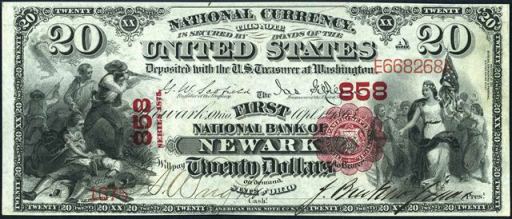
The first twenty dollar national bank notes issued can be original series notes or series of 1875 notes. Original series notes have a spiked seal as seen below. Series of 1875 notes have a round seal as seen above. In reality, the type of seal doesn’t matter much. It is still mostly about condition and bank of issue.
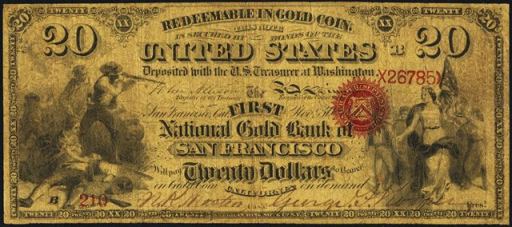
Several banks in California issued national gold bank notes. The twenty dollar denomination is the highest denomination that is really collectible. As with most national gold bank notes, the twenty dollar bills are usually heavily circulated.
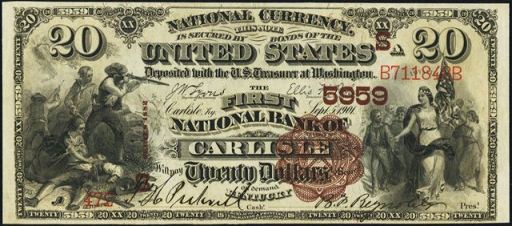
Series of 1882 brown backs were printed between 1882 and 1908. These issues have a chance to be really rare and collectible. The twenty dollar denomination is probably the least popular of the five denominations issued for the brown back series. However, condition, serial number, and bank of issue drive the value more so than the denomination on these national bank notes.
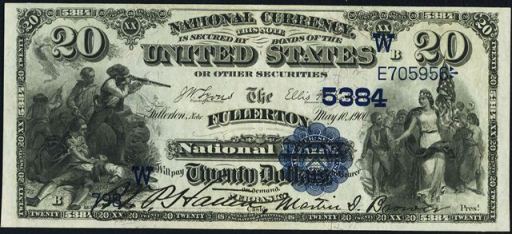
The note shown above is what the front of an 1882 date back looks like. These have a similar design to all twenty dollar national bank notes that were printed in the 19th century. The left hand side of the bill shows a man aiming a rifle. The right hand side of the bill shows lady liberty carrying a flag. The back of these notes have the dates “1882 – 1908” printed prominently on them. These issues aren’t especially popular, but they can still be valuable.
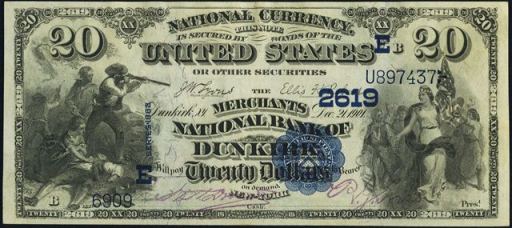
1882 date backs and value backs have a front design that is exactly the same. The difference between the two can be seen on the back of each bill. The value back has the denomination of the bill “twenty dollars” printed in the center of the bill. Value backs are actually fairly scarce. Even if they are from a common bank, they can still be valuable just based on the signature combination. I strongly advise you to send a picture of any note you have so I can assist in variety determination.
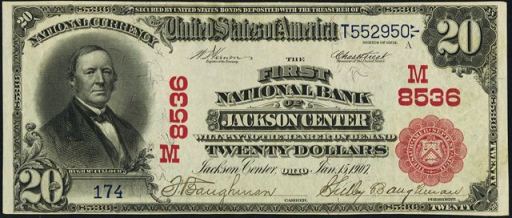
Red seals are always popular. However, the series of 1902 $20 red seal national bank note doesn’t quite have the same eye appeal as the other denominations. Even though these aren’t the most impressive notes (in my opinion) they can still be exceedingly rare. It all depends on which bank issued them. These were only printed between 1902 and 1908. Millions were printed, but only hundreds have survived.
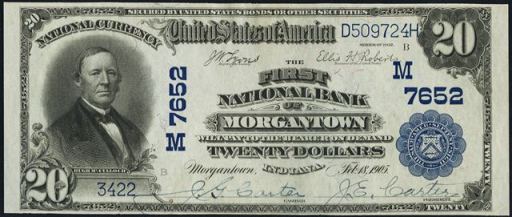
Hugh McCulloch is featured on all 1902 $20 national currency bills. The later issued series of 1902 notes were printed from 1908 until 1929. These will all have blue seals. All blue seal national bank notes can be common or exceedingly rare. Once again, it is all about bank rarity and condition. I would be happy to advise on values if you send a picture of what you have.
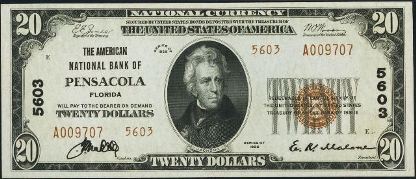
1929 national bank notes come in two types. The variety above is known as a type2. It has a serial number that does not end with a letter. Type1 varieties all have a serial number that ends with the letter A. These notes are usually fairly available. However, if your serial number is below 1000 then it has a good chance to be rare and worth at least a few hundred dollars. Andrew Jackson is the central figure on each of these bills.
Please send pictures of your twenty dollar bill. I would like a chance to make an offer. Thanks. Sales@AntiqueMoney.com


